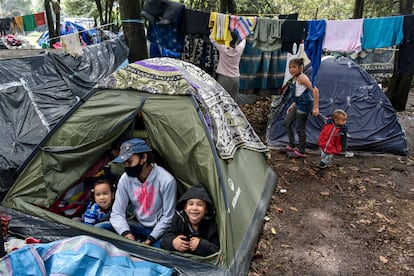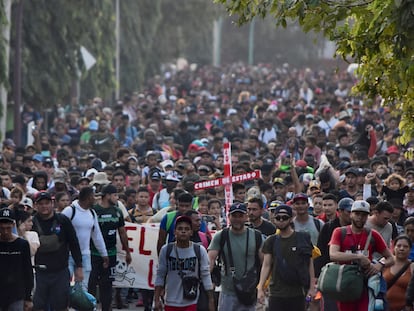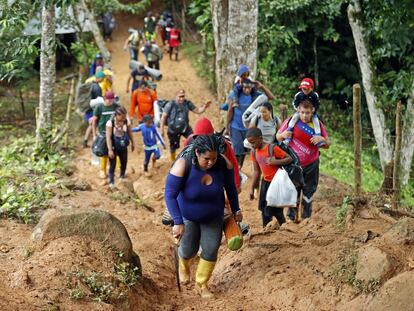A host community strategy for managing migration
To head off chaos, as part of a multipronged approach to manage and order migration, it is time for decisive action to stabilize migrant hosting communities throughout the Americas

From the once-impenetrable Darién jungle to the U.S.-Mexico border to U.S. interior cities like New York and Chicago — all straining under increased numbers of migrants — displacement in the Americas appears on the verge of spiraling out of control.
To head off chaos, as part of a multipronged approach to manage and order migration, it is time for decisive action to stabilize migrant hosting communities throughout the Americas – of which there are far more than is commonly appreciated in the United States.
Today, nearly 20 percent of the world’s displaced population is from Latin America and the Caribbean, a region that accounts for only 8 percent of the global population. Critically, the vast majority of the displaced are not coming to the United States in no small measure because of Latin America and the Caribbean’s remarkable, if underappreciated, success in managing historic levels of displacement.
Take the largest single group in the Americas — the more than 7.7 million Venezuelans forced to flee since 2015. More than 84 percent today live elsewhere in the region, including nearly 3 million in neighboring Colombia, a country of 50 million. The United States, by comparison, is home to only 6 percent of the Venezuelan diaspora. The same is true of other significant migrant populations. Costa Rica, a country of 5 million and home to more than 300,000 Nicaraguans, as well as Mexico rank among the global leaders in receiving asylum applications.
A key to the region’s success has been an effort to rapidly integrate migrant populations. Providing basic social services and — in the most successful cases — the formal ability to work has shortened considerably the time it takes new populations to transition from being fiscal burdens to fiscal contributors. City-led integration efforts in places like Bogotá and Barranquilla, Colombia, have empowered both to manage migrant-driven 10 percent population growth in ways from which other cities throughout the Americas have much to learn.
Colombia’s 10-year temporary protection for Venezuelans is the best-in-class example of national-level, enabling legislation, but it is not alone. Most recently, Panama, a country traditionally reluctant to embrace irregular migrants, has begun implementing its own temporary protection regime.
But the region’s absorption capacity is reaching a break point following the economic wreckage of the COVID-19 pandemic; energy and food market disruptions sparked by Russia’s invasion of Ukraine; capital flight and increased debt financing burdens as U.S. interest rates rise; among other geopolitical headwinds. Tight fiscal conditions are making it harder to reactivate economies and support communities hosting significant migrant populations.
A bold host community stabilization plan is needed to open fiscal space for countries absorbing large numbers of migrants; re-incentivize their welcoming policies; and reverse this trend. Doing so is not a task for direct U.S. taxpayer-supported foreign assistance. The billions needed must be mobilized by development finance institutions working in concert with governments, the private sector, and philanthropy. Over time, a scaled host community stabilization plan will require reform and recapitalization of critical institutions like the Inter-American Development Bank, or IDB, but immediate action is possible.
Through a multi-donor guarantee fund, for example, the United States, together with others like Spain, Canada and perhaps even regional economic leaders like Mexico and Brazil, could facilitate financing for middle income countries hosting significant migrant populations at or near concessional terms conditioned on investment in regularization and integration efforts. The fund could operate similar to either the International Finance Facility for Education, which leverage a combination of tens of millions of paid-in capital and grants, or the Innovative Finance Facility for Climate in Asia and the Pacific, which uses financial guarantees to reduce risk on sovereign loans, to unlock billions in concessional finance for lower middle income countries.
The IDB and the World Bank recently pledged greater collaboration. As a principal shareholder in each, the United States must insist the banks, consistent with the Los Angeles Declaration on Migration and Protection’s June 2022, work to raise their ambition and coordination to support migrant integration and inclusion efforts. Both should target efforts to mobilize private capital toward investment in important host community cities, where it could catalyze growth essential to stabilizing both displaced and would-be migrant populations.
Seeking to unlock greater financing for pressing global challenges, the IDB and African Development Bank have jointly proposed rechanneling International Monetary Fund Special Drawing Rights, or SDRs, through multilateral development banks to take advantage of the banks’ capacity to leverage. In the Americas, a host community stabilization plan — perhaps tailored to communities hosting those displaced by the climate crisis — should be a principal beneficiary of such creative development financing.
A host community strategy is one component of a needed multipronged approach to mitigate and manage migration. One with a proven track record of success across the Americas that must be reinforced — at scale — before it is too late.
Sign up for our weekly newsletter to get more English-language news coverage from EL PAÍS USA Edition
Tu suscripción se está usando en otro dispositivo
¿Quieres añadir otro usuario a tu suscripción?
Si continúas leyendo en este dispositivo, no se podrá leer en el otro.
FlechaTu suscripción se está usando en otro dispositivo y solo puedes acceder a EL PAÍS desde un dispositivo a la vez.
Si quieres compartir tu cuenta, cambia tu suscripción a la modalidad Premium, así podrás añadir otro usuario. Cada uno accederá con su propia cuenta de email, lo que os permitirá personalizar vuestra experiencia en EL PAÍS.
¿Tienes una suscripción de empresa? Accede aquí para contratar más cuentas.
En el caso de no saber quién está usando tu cuenta, te recomendamos cambiar tu contraseña aquí.
Si decides continuar compartiendo tu cuenta, este mensaje se mostrará en tu dispositivo y en el de la otra persona que está usando tu cuenta de forma indefinida, afectando a tu experiencia de lectura. Puedes consultar aquí los términos y condiciones de la suscripción digital.
More information

To effectively manage migration — go bigger

The Darién Gap and promise in the Americas
Archived In
Últimas noticias
Most viewed
- Sinaloa Cartel war is taking its toll on Los Chapitos
- Oona Chaplin: ‘I told James Cameron that I was living in a treehouse and starting a permaculture project with a friend’
- Reinhard Genzel, Nobel laureate in physics: ‘One-minute videos will never give you the truth’
- Why the price of coffee has skyrocketed: from Brazilian plantations to specialty coffee houses
- Silver prices are going crazy: This is what’s fueling the rally








































